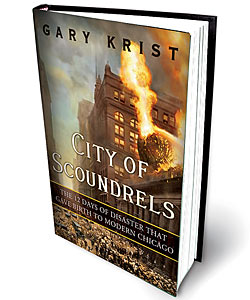
Think Blago was the first Chicago politician to adopt a larger-than-life swagger? That tradition stretches back at least a century. More surprising is the idea that all of the bluster and bravado can actually serve the public. In his new book, City of Scoundrels: The 12 Days of Disaster That Gave Birth to Modern Chicago (out April 17 from Crown, $26), the author and journalist Gary Krist argues that Chicago survived the bloody summer of 1919—when a tinderbox of issues, from job and housing shortages to a series of bombings targeting the black community, came to a fiery head—in part due to the force of nature that was its progressive mayor, Bill Thompson. For more on Krist’s theory, you’ll have to consult his riveting book. For a timeline of key events from those hellish two weeks, read on.
JULY 21, 1919 | MONDAY
On the third voyage of its first day of test flights, the Wingfoot Express, a Goodyear blimp, catches fire 1,200 feet above the Loop. Engulfed in flames, the airship plunges into the Illinois Trust and Savings Bank, just north of the Board of Trade, shortly after 5 p.m. The nation’s first major aviation disaster results in a death toll of 13.
JULY 22, 1919 | TUESDAY
Around 6 p.m., Mr. and Mrs. John Wilkinson, Scottish immigrants and storekeepers, arrive at the Chicago Avenue police station in the Gold Coast to report their six-year-old daughter, Janet, missing.
JULY 23, 1919 | WEDNESDAY
Just after 2 a.m., police bring in Thomas Fitzgerald, a neighbor of the Wilkinsons and the chief suspect in Janet’s disappearance, for questioning. . . . Not long before midnight Thursday, Mayor Big Bill Thompson, a blue-blood-turned-self-appointed-cowboy, departs Union Station bound for a Wild West weekend in Cheyenne, Wyoming, with many of the city’s bigwigs—the police chief, John Garrity, among them—in tow, leaving the city virtually untended.
JULY 25, 1919 | FRIDAY
With Garrity out of town, his deputy, John Alcock, responds to the sudden flurry of parents reporting assaults on children by calling for the incarceration of all suspected “morons,” the term of the time for mentally deficient deviants.
JULY 26, 1919 | SATURDAY
Believed to have recovered from a nervous breakdown brought on by the Spanish flu, Harry P. Dolan, an associate justice of the municipal court, leaps to his death from the 11th floor of City Hall.
JULY 27, 1919 | SUNDAY
At 8:13 a.m. on his 39th birthday, after 102 hours in custody, Fitzgerald confesses to enticing Janet into his apartment, choking her to death, and burying her body in the basement. . . . That afternoon, five black teens rafting along the lakefront unwittingly drift into a racially motivated brawl at 29th Street Beach. One of the boys drowns after being struck by a rock. Shots are fired, and the melee spills west. By evening, roving white gangs—or self-styled “athletic clubs,” including that of 17-year-old Richard J. Daley, the Hamburgs—stalk the South Side. Race riots ensue.
JULY 29, 1919 | TUESDAY
Following days of stalled talks, the transit union declares a system-wide strike. By 4 a.m., Chicago is immobilized amid the ongoing riots. . . . With most police posted to the so-called Black Belt, a white mob of 500 storms the Loop, planning to seize the Palmer House hotel’s black kitchen staff. . . . Meanwhile, 150 black inmates stage an uprising at the county jail. . . . After attending a meeting led by the activist Ida Wells-Barnett, Carl Sandburg writes his impassioned poem “Hoodlums” (“let us too yammer, ‘Kill him! kill him!’”).
JULY 30, 1919 | WEDNESDAY
By 10:30 p.m., 112 fire alarms have sounded. Citing reports of an arson plot designed to set the entire South Side aflame, Thompson, back in Chicago, calls in the militia.
AUGUST 1, 1919 | FRIDAY
Following a union vote, the transit strike ends minutes before midnight. In the days after—as violence declines, a new ban on “promiscuous aviation” passes, and the proposal for an “institution for morons” is introduced—Thompson behaves as if life were back to normal. Little does he know what events—the Black Sox scandal of 1919, the Palmer raids of 1920—will demand his attention next.



